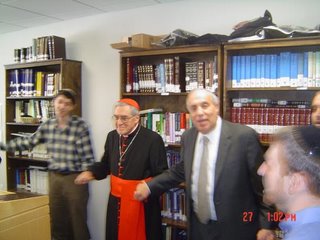...that is what the newspaper headlines may be in the future. There is interesting circumstantial evidence that this is the direction that YCT may eventually go in.
The Past: Let's start at the top of the slope...The 1998 cover story from Religion & Ethics, "
Women Rabbis" (Episode no. 124. 2/13/1998) featured the first Orthodox woman "Congregational Intern" at the Hebrew Institute of Riverdale, instituted by Rabbi Avi Weiss (rabbi of HIR and founder and dean of YCT).
MARY ALICE WILLIAMS: What you are looking at is a revolution, an innovation in Orthodox Judaism, and it's embodied in this 24-year-old. Sharona Margolin Halickman has broken through a gender barrier unbreached for 5,000 years. She is one of the first women to serve in a professional role like this in a Orthodox synagogue. Her title is Congregational Intern. She is not a rabbi, but she's darn close.
...
Rabbi MOSHE FASKOWITZ (National Council of Young Israel): What we've always learned is that it starts very innocently, very quietly and eventually -- there's an agenda here, and eventually what will happen is this internship will grow into a different kind of position, and it will be a different job definition, and it will include those areas in which women are absolutely prohibited.
Rabbi Avi WEISS: I respectfully disagree. I think that this enhances spirituality and brings more women into our fold. But look, when you do something that's different, it's bound to create controversy.
...
Ms. HALICKMAN: If we use the term "rabbi," you know, for something similar to what I'm doing, it would really exclude most of the Orthodox community, and it wouldn't become accepted, and we want to keep it accepted within the Orthodox community.
The Present: What's good for the faculty is good for the studentsRabbi B. Elka Abrahamson was listed as a member of the
YCT adjunct faculty. She received ordination from Hebrew Union College, a Reform seminary.
Rabbi Naomi Kalish, a Conservative woman rabbi, has also been listed as a member of the YCT adjunct faculty. All YCT instructors teach seminary-related classes. YCT is a rabbinical seminary, not a 4-year university.
By listing the title "Rabbi" before a man's or woman's name, YCT is certainly acknowledging that anyone with that title is recognized as a rabbi. I see no YCT distinction in the rabbinical title of their women rabbi faculty from that of Rabbi Avi Weiss (Dean) or Rabbi Dov Linzer (Rosh Yeshiva).
Based on their Reform and Conservative women rabbi faculty precedents, YCT may eventually hire an Orthodox woman rabbi. Recently, a
woman received Orthodox rabbinical ordination (it was not from YCT, and it was noted that it was not exactly the same as for men). More Orthodox woman rabbis may follow.
If women rabbis are good enough to teach YCT male seminary students, then why shouldn’t YCT also ordain those same women? At a private religious seminary, doesn’t the student body typically reflect the faculty?
Anything you can do, I can do better
Ms. Dina Najman, an Orthodox woman, was
appointed spiritual leader of an Orthodox-oriented congregation.
Concerning Ms. Najman’s appointment, Rabbi Dov Linzer, Rosh Yeshiva of Chovevei Torah, stated “She can do a better job than a large number of rabbis just coming out of rabbinical school.”
I will assume that Rabbi Linzer is referring to male orthodox rabbis ”just coming out of rabbinical school”. So, doesn’t his comment imply a rhetorical follow-up question…”Why not make her a rabbi?”
Rabbi Linzer’s comment can also be perceived as a backhanded compliment that Ms. Najman may better qualified than many men, but because she is an Orthodox woman she can never obtain the status/title of Orthodox rabbi.
Why even compare Ms. Najman to male rabbis? Why not compare her to learned men and women - focusing on her abilities instead of titles? Or better yet, why compare at all?
The Future...Will YCT or a YCT sister school eventually ordain women rabbis? Only time will tell…
Side point: In the Hebrew language, the title "rabbi" may not be grammatically correct for a woman, however "rabbi" is unisex in the English vernacular. See
On the Grammatical Question of Women Rabbis by YCT student, Drew Kaplan
Labels: feminism, general controversy, hashkafa, interdenominational, pluralism





